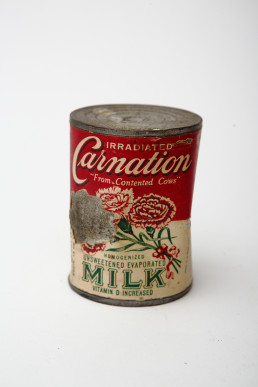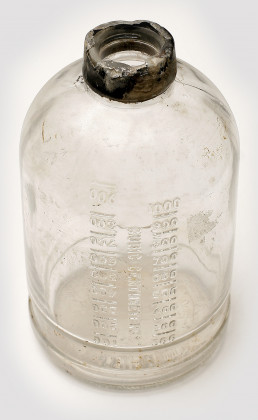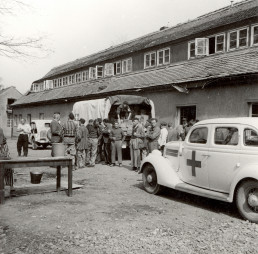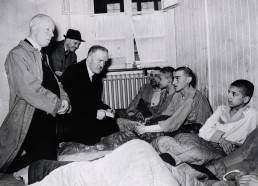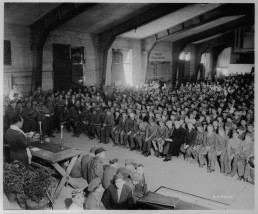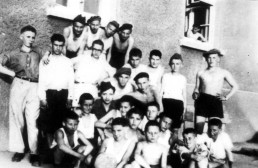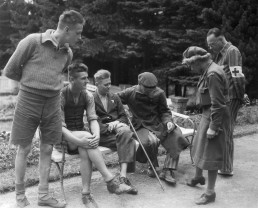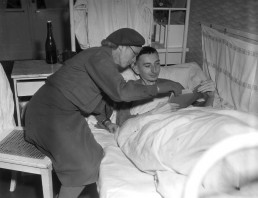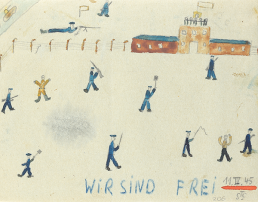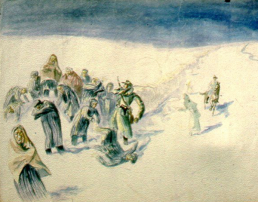Life in the liberated camp
Many liberated prisoners were in a deplorable condition. Some were more dead than alive. Despite self-sacrificing help from US medics and civilian helpers, hundreds of people still died from the effects of imprisonment in Buchenwald and Mittelbau-Dora in the weeks after liberation. Some were unable to digest the fatty foods they had been given by the helpers.
At Buchenwald, the US troops moved the 900 or so liberated children and young people from the filthy camp barracks to better accommodations, many of them to the former SS buildings. International relief organizations and the US Army organized aid for the young survivors. The US military Rabbi Herschel Schacter stayed in the camp for months to care for the orphans and provide pastoral support.
The International Red Cross delivers medicine to the liberated Buchenwald camp, 17-18 April 1945.
In the first days after the liberation, there was an acute shortage of medical supplies. The seriously ill and starving children were supplied with medicine and food by the International Red Cross.
(Buchenwald Memorial)
American congressmen visit liberated prisoners in the former camp brothel, which was converted into a hospital ward, 21 April 1945.
(Buchenwald Memorial)
"At the time this unit took over the camp there were an estimated 21,000 prisoners there. The greatest problem facing the unit was one of sanitation. The water supply had been cut off due to the destruction of one of the mains by explosives. Latrine facilities in the camp were virtually non-existent and hygiene of any kind was apparently unknown. Prisoners' barracks were in the worst possible condition. Lighting was inadequate, barracks were filthy, barracks overcrowded, inmates underfed and underclothed. Upon taking over the camp, the unit began delousing and cleaning buildings which had formerly housed SS guards. As these buildings were cleared, the worst cases were transferred."
Excerpt from the report of the 120th US Evacuation Hospital, 10 June 1945.
The US liberators wrote a report on the disastrous sanitary conditions in the camp. They set up an emergency hospital.
(Buchenwald Memorial)
Jewish service in the cinema barracks at Buchenwald, 18 May 1945.
The US military chaplain Rabbi Herschel Schacter arrived at Buchenwald with the 3rd US Army on 11 April 1945, and remained there until June. He was especially committed to the Jewish orphans. The photo was taken at one of the services. The boy sitting in the front row with shorts is Robert Buechler. Sitting in front of the lectern, looking at the camera, is six-year-old Stefan Jakubowicz.
(Buchenwald Memorial)
"He arrived at Buchenwald as the first Jew, the Rabbi Schacter. He made ... it was the time of Passover or something. He distributed matzos, and he held services."
Jurek Kestenberg, in an interview with David P. Boder, recalls a service with Rabbi Schacter, 31 July 1946.
(„Voices of the Holocaust“, Illinois Institute for Technology)
"From floor to ceiling were hundreds upon hundreds of men and very few boys who were strewn over scraggly straw sacks looking down at me, looking down at me out of dazed eyes. [...] I remember their eyes, looking down, looking out of big, big eyes - that's all I saw were eyes - haunted, crippled, paralyzed with fear. They were emaciated skin and bones, half-crazed, more dead than alive. And there I stood and shouted in Yiddish "Sholem Aleychem, Yiden, yir zent frey!" "You are free." The more brave among them slowly began to approach me [...], to touch my Army uniform, to examine the Jewish chaplain's insignia, incredulously asking me again and again, "Is this true? Is it over?"
“You are free!” Report by Rabbi Herschel Schacter, 1981.
(Buchenwald Memorial)
Survivors of the Mittelbau-Dora Concentration Camp in a sanatorium in Sülzhayn (Harz Mountains), 29 June 1945.
The Americans brought several hundred survivors from the Mittelbau Concentration Camps to two sanatoriums in the spa town of Sülzhayn near Ellrich for recuperation. There, nurses from UNRRA (United Nations Relief and Rehabilitation Administration) cared for them.
(Photo: Edward Vetrone, NARA)
Liberations
Liberated in Buchenwald and Mittelbau Dora
In the fall of 1944, the SS began to clear the camps in the east. Tens of thousands of prisoners arrived at Buchenwald and Mittelbau-Dora on evacuation transports from Auschwitz and…
Liberated on death marches
As Allied troops approached in early 1945, the SS began to clear the first subcamps of the Buchenwald Concentration Camp, evacuating the prisoners to the main camp or to other camps.
